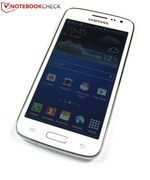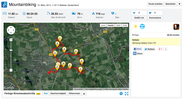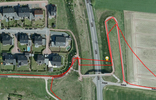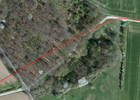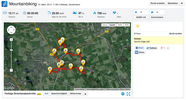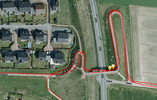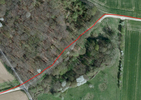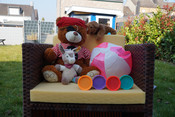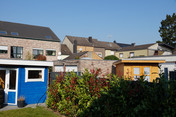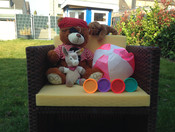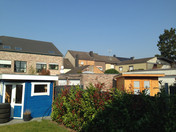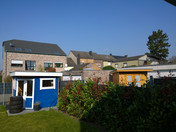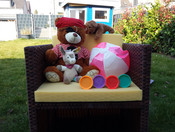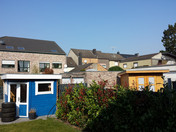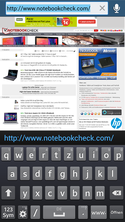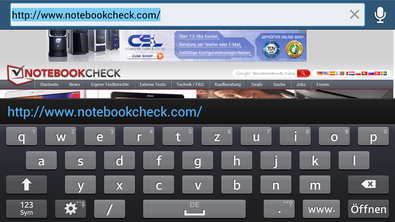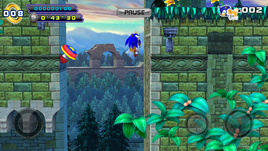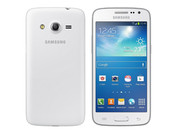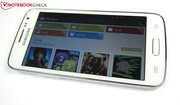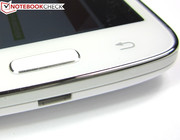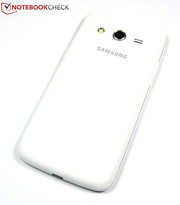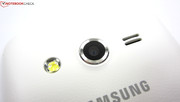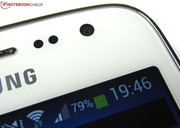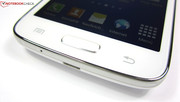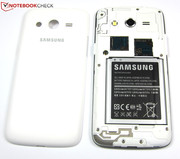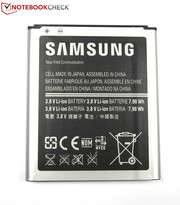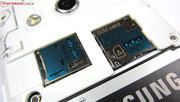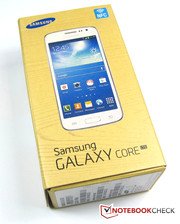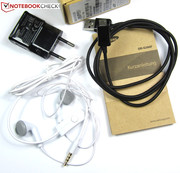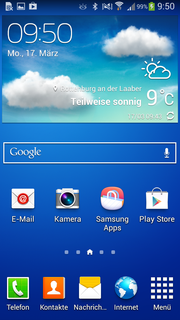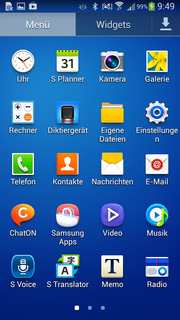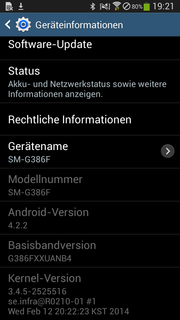Review Samsung Galaxy Core LTE SM-G386F Smartphone

For the original German review, see here.
Samsung's Galaxy Core LTE SM-G386G joins the race as the successor of the Galaxy Core line and displays the main purchase argument directly in its product name. That is the support of the high-speed, wireless LTE standard installed in the Cat4 version in Samsung's smartphone. It enables theoretical transfer rates of up to 150 Mbit/s - providing the matching mobile service plan has been selected and the user is in an area where such high LTE bandwidths can be transmitted.
When the LTE crowd-puller is left aside, only an average though not at all bad 4.5-inch smartphone is left over. Powered by a Renesas MP5232 dual-core SoC and PowerVR SGX544 graphics chip, Samsung's Galaxy Core LTE SM-G386F can fall back on 1 GB of RAM and 8 GB of storage. This is supplemented by Android 4.2.2, a 5-megapixel primary camera, and a screen resolution of 960x540 pixels, not to mention appealing looks as known from the members of Samsung's Galaxy line.
Case
The large Samsung Galaxy Core LTE SM-G386F seamlessly merges into the range of Galaxy S4 models that clearly closely follow the design of the Galaxy S3 range. Samsung relies on a high-quality processed, rigid and very stiff polycarbonate chassis also for its new 4.5-inch smartphone. It could neither be twisted nor bent even when using higher force in our tests.
The lightly rubber-coated and patterned back provides the fingers with a secure hold. The rounded edges and corners of the 10-millimeter thin casing, available in black or white, contribute to the good overall impression. That and the surrounding metal bezel give the LTE smartphone a very stylish look. Although the latter boosts the weight of the Galaxy Core LTE SM-G386F to a relatively high 137 grams, it is not inconvenient in use. Besides that, some 4.5-inch contenders weigh even more, for example Acer's Liquid E2 Duo with 140 grams.
Connectivity
The Renesas MP5232 dual-core SoC powers Samsung's Galaxy Core LTE SM-G386F. Its cores clock with 1.2 GHz. It is supported by the integrated PowerVR SGX544 graphics chip, 1 GB of RAM, and a low 8 GB of storage. In fact, only approximately 5 GB is available when the storage that Android 4.2.2 and the various pre-loaded apps are deducted. At least the main storage can be expanded up to 64 GB via a micro-SD card.
Software
The Galaxy Core LTE SM-G386F relies on the not quite latest Android 4.2.2, but Samsung treats the LTE smartphone to its user interface dubbed TouchWiz. It convinces with its colorful and at the same time clearly arranged design, and it facilitates finding the desired content, for example, via a widget bar at the screen's edge. The major difference to the default interface is found in system settings that are divided into four categories dubbed "Connections," "My Device," "Accounts," and "Options." Samsung pre-loads countless apps on the Galaxy Core LTE SM-G368F that are distributed over two screens due to their number. Among others, we find the Chrome browser, Google+, YouTube, Google Play, and TripAdvisor. The well-known Samsung apps S Voice (voice control), S Translator (translation tool), and S Planner (calendar) are also included.
Communication & GPS
Samsung equips the Galaxy Core LTE SM-G386F with all common communication modules, among others with LTE Cat4 that clearly sticks out as the highlight. Download rates up to 150 MBit/s are possible with the matching mobile service plan. Wireless data connections are performed via Wi-Fi 802.11 b/g/n including Wi-Fi Direct, Bluetooth 4.0, and NFC. The manufacturer covers telephony with the GSM quad-band (850/900/1800/1900 MHz) and UMTS dual-band (900/2100 MHz).
The integrated A-GPS sensor is responsible for determining the position, which enables quick localization both outdoors and indoors. However, the GPS module in the Galaxy Core LTE SM-G386F did not exactly perform well in our practical test over a 10-kilometer bike route. Compared with the Garmin Edge 500 navigation system, the review sample only did a middling job. The smartphone deviated several meters from the route, particularly in dense and wooded sections.
Telephony & Speech Quality
Telephony does not give reason for complaint. The Galaxy Core LTE SM-G386F always provided an immaculate speech quality in both landline and mobile network calls. We did not ascertain any noises, interruptions or disconnections.
Cameras & Multimedia
The 5-megapixel primary camera in the Galaxy Core LTE SM-G386F has a four-time optical zoom including flash, and a maximum resolution of 2560x1920 pixels (4:3). Pictures with up to 2560x1440 pixels are possible in the 16:9 format. Samsung's smartphone can record videos in the "small" HD format of 1280x720 pixels. However, the webcam can only shoot VGA quality with 640x480 pixels, which is just still sufficient for video-chat selfies.
As can be seen on the sample photos, the Galaxy Core LTE SM-G386F delivers a decent picture quality, but it cannot compete with premium smartphones like Apple's iPhone 5, Google's Nexus 4, Nokia's Lumia 920 or Samsung's Galaxy S4, because the pictures lack the last bit of contrast. They also quickly look blurry in unfavorable light conditions.
Accessories & Warranty
A micro-USB cord, modular power supply, in-ear headphone, and a quite comprehensive quick-start guide are found in the box of Samsung's Galaxy Core LTE SM-G386F. The manufacturer does not offer any special accessories for the smartphone on its website. The Galaxy Core LTE SM-G386F comes with a 24-month warranty.
Input Devices & Controls
The Galaxy Core LTE SM-G386F adopts the good handling properties of Samsung's Galaxy smartphones. The 4.5-inch smartphone responds immediately to inputs, regardless of whether they are made via the Android buttons, the virtual keyboard or multi-touch gestures. We also liked the swiftly implemented screen rotation and virtual keyboard that features sufficiently sized keys even in portrait mode. The only restriction is that the dual-core sometimes needs a moment to start another application when several apps are running in the background. However, this is not really a drawback because this will unlikely happen very often.
Display
The 4.5-inch screen of the Galaxy Core LTE SM-G386F reproduces 960x540 pixels, which is a common resolution for this format. Samsung's S3 Mini only accomplishes 800x480 pixels. Neither device can compete with Motorola's Moto G that reproduces 1280x720 pixels on its screen. An interesting detail is that while many smartphones support five or even 10 simultaneous finger inputs, our review sample can only cope with a maximum of three.
The Galaxy Core LTE SM-G386F achieves an above-average result with a brightness of 389.9 cd/m² and a homogeneous illumination of 89%. Even the black level of 0.45 cd/m² and the contrast ratio of 916:1 are both good rates. Neither Samsung's S3 Mini (264.6 cd/m²) nor Acer's Liquid E2 Duo come close to the brightness rates of Samsung's smartphone. However, Motorola's Moto G with 416.8 cd/m² marks the top of the rankings.
| |||||||||||||||||||||||||
Brightness Distribution: 89 %
Center on Battery: 412 cd/m²
Contrast: 916:1 (Black: 0.45 cd/m²)
ΔE ColorChecker Calman: 5.19 | ∀{0.5-29.43 Ø4.79}
ΔE Greyscale Calman: 5.94 | ∀{0.09-98 Ø5}
Gamma: 2.41
CCT: 7979 K
Our measurements with the colorimeter and CalMAN software assess the color accuracy, saturation and grayscale reproduction of the QHD screen. The Galaxy Core LTE SM-G386F's red reproduction is too pale and the blue colors are overemphasized, which results in a quite high DeltaE rate of 5.19 that is the shift from the ideal rates of the sRGB color space. The screen also deviates from the ideal in the grayscale, in particular the light gray hues are emphasized too strongly (DeltaE of 5.94). However, these shortcomings are not noticed subjectively because the color reproduction always looks crisp, rich in contrast and natural.
The Galaxy Core LTE SM-G386F can easily be used outdoors owing to its bright LCD screen. Like with every modern smartphone, the review sample's highly reflective screen surface could prove adverse for outdoor fun. Barely anything can be recognized in direct sunlight. However, it is usually enough to turn the screen a bit for a clear view.
Performance
Samsung's Galaxy Core LTE SM-F386F relies on the Renesas MP5232 dual-core SoC with a clock frequency of 1.2 GHz. The PowerVR SGX544 takes over graphics calculations. Both SoC components can fall back on 1 GB of RAM.
Samsung's smartphone is on par with comparably configured devices in the synthetic benchmarks, and it is even with Acer's Liquid E2 Duo in most tests. However, Motorola's Moto G has an overall clear lead and reaps in a distinct advantage in 3DMark 2013, Basemark ES 2.0, and Linpack.
| 3DMark - 1280x720 Ice Storm Standard Score (sort by value) | |
| Samsung Galaxy Core LTE SM-G386F | |
| Motorola Moto G 1. Gen XT1032 | |
| Acer Liquid E2 v370 | |
| Epic Citadel - High Quality (sort by value) | |
| Samsung Galaxy Core LTE SM-G386F | |
| Motorola Moto G 1. Gen XT1032 | |
| Acer Liquid E2 v370 | |
| Basemark ES 2.0 - Taiji Free (sort by value) | |
| Samsung Galaxy Core LTE SM-G386F | |
| Samsung S3 Mini GT-I8190 | |
| Motorola Moto G 1. Gen XT1032 | |
| Acer Liquid E2 v370 | |
| Linpack Android / IOS - Multi Thread (sort by value) | |
| Samsung Galaxy Core LTE SM-G386F | |
| Samsung S3 Mini GT-I8190 | |
| Motorola Moto G 1. Gen XT1032 | |
| Acer Liquid E2 v370 | |
The comparison devices are close in the browser benchmarks, with exception of Samsung's S3. The Galaxy Core LTE SM-G386F again almost pulls even with Acer's Liquid E2 Duo, and Motorola's Moto G is again at the very front.
| Google V8 Ver. 7 - Google V8 Ver. 7 Score (sort by value) | |
| Samsung Galaxy Core LTE SM-G386F | |
| Samsung S3 Mini GT-I8190 | |
| Motorola Moto G 1. Gen XT1032 | |
| Acer Liquid E2 v370 | |
| Browsermark - --- (sort by value) | |
| Samsung Galaxy Core LTE SM-G386F | |
| Samsung S3 Mini GT-I8190 | |
| Motorola Moto G 1. Gen XT1032 | |
| Octane V1 - Total Score (sort by value) | |
| Samsung Galaxy Core LTE SM-G386F | |
| Motorola Moto G 1. Gen XT1032 | |
| Acer Liquid E2 v370 | |
| Peacekeeper - --- (sort by value) | |
| Samsung Galaxy Core LTE SM-G386F | |
| Samsung S3 Mini GT-I8190 | |
| Motorola Moto G 1. Gen XT1032 | |
| Acer Liquid E2 v370 | |
Sequential and random read and write operations are definitely not one of the Galaxy Core LTE SM-G386F's favorite tasks. Apart from sequential write, Acer's Liquid E2 Duo and Motorola's Moto G always score better. Only Samsung's S3 Mini does an even poorer job than our review sample.
Games
Although the Galaxy Core LTE SM-G386F does not sport an especially strong SoC, up-to-date games run smoothly. That is equally true for basic 2D titles and more demanding games, such as Dungeon Hunter 4 and Sonic 4 Episode II.
Emissions
Temperature
The LTE smartphone heats up to a maximum of 38.4 °C during load, and is thus within an absolute acceptable temperature range. It is only 30.9 °C in idle. The competition achieves similarly low rates, although both Motorola's Moto G with 34.6 °C and Samsung's S3 Mini with 34.4 °C remain slightly cooler than the Galaxy Core LTE SM-G386F during load.
(+) The maximum temperature on the upper side is 38.4 °C / 101 F, compared to the average of 35.2 °C / 95 F, ranging from 21.9 to 247 °C for the class Smartphone.
(+) The bottom heats up to a maximum of 35.5 °C / 96 F, compared to the average of 34 °C / 93 F
(+) In idle usage, the average temperature for the upper side is 28.2 °C / 83 F, compared to the device average of 32.9 °C / 91 F.
Speakers
Samsung places the sole speaker directly beside the primary camera on the casing's back. As is common for smartphones, it produces a rather thin sound. However, the small sound membrane's maximum volume is downright loud, and no distortions are audible. Stereo sound is first available via the included in-ear headphones.
Energy Management
Power Consumption
The Galaxy Core LTE SM-G386F consumes between 0.7 and 1.6 watts when idling and is thus very energy efficient. The load rates are not much higher with 2.0 to 2.4 watts. The comparison devices are equally frugal; only Acer's Liquid E2 Duo and Motorola's Moto G both reach marginally higher peak consumptions with 2.8 watts.
| Off / Standby | |
| Idle | |
| Load |
|
Key:
min: | |
Battery Runtime
The combination of low power consumption and high-capacity battery (7.98 watt hours) gives hope for long battery runtimes. The Galaxy Core LTE SM-G386F did not let us down in this regard but did not prove to be a runtime miracle either. Samsung's smartphone achieved an excellent time of 23 hours and 13 minutes in the maximum runtime test using minimum screen brightness, enabled energy-saving features, and all wireless technologies except for Wi-Fi off. It is only defeated by Motorola's Moto G with 25 hours and 15 minutes.
It continues with a good average: Samsung's Galaxy Core LTE SM-G386F accomplished 10 hours and 46 minutes in the Wi-Fi test where websites are opened every 40 seconds via a script and using a screen brightness of 150 cd/m² and enabled energy-saving features. Thus, both Acer's Liquid E2 Duo (12 hours and 34 minutes) and Motorola's Moto G (15 hours and 30 minutes) last longer. The runtime decreased to 3 hours and 56 minutes in full load using maximum screen brightness and all wireless modules on, which is also a good rate in the comparison. Motorola's Moto G achieves 4 hours and 4 minutes, and Samsung's S3 Mini lasts 4 hours and 20 minutes.
Verdict
Samsung sends a 4.5-inch smartphone dubbed Galaxy Core LTE SM-G386F into the race, which particularly convinces in three things: Its price that was approximately 260 Euros (~$361) at the time of writing, the high-speed LTE Cat4 wireless module with transmission rates of up to 150 Mbit/s, and its high-quality build including the surrounding metal bezel that makes the smartphone look as if it were one piece. It also proved to be just as stable. The Galaxy Core LTE SM-G386G easily defied all twisting, warping and pressure attempts in the test.
However, the bargain price of Samsung's smartphone also involves a few cutbacks in other places. For example, the Galaxy Core LTE SM-G386F only sports a Renesas MP5232 dual-core SoC, 1 GB of RAM, and a low 8 GB of main storage. The latter is even reduced to 5 GB by the now older Android 4.2.2 version alongside the pre-loaded apps. Storage expansion via a micro-SD is almost a must in this case. Nevertheless, buyers who can live with these shortcomings will find a solid smartphone with a just as solid 5-megapixel camera that does not give reason for complaint in terms of battery runtime or picture quality.




